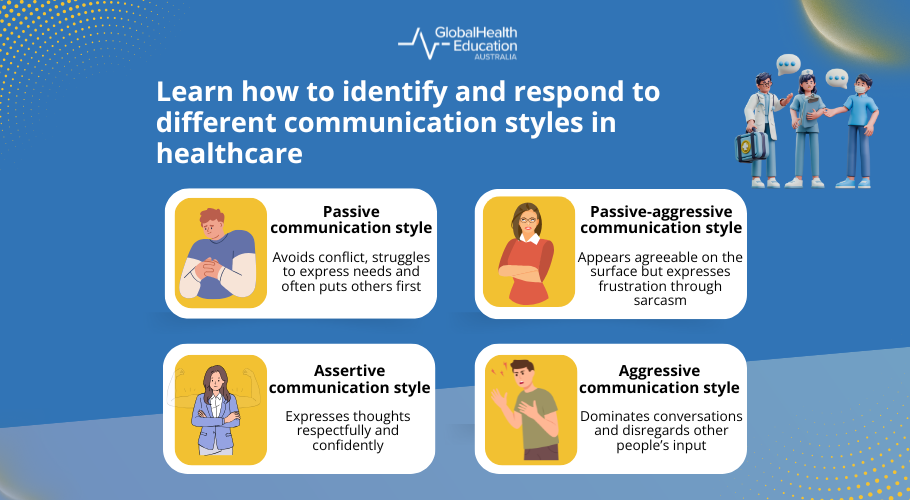In This Article
- What is effective communication in healthcare?
- Why effective communication is vital in healthcare
- The different types of communication styles in healthcare and how to identify them
- How to respond to each type of communication style
- Understanding the modes of communication in healthcare
- Tips on improving your communication skills in a healthcare setting
- Strengthen your communication skills to become a better healthcare professional
No matter where you work in healthcare, you’ll likely be communicating with diverse groups of people every day. In clinical settings, this could involve speaking with patients, clients or their family members and in non-clinical roles, it may mean interacting with colleagues or various stakeholders.
Given these varied interactions, it’s important to be able to recognise different communication styles and respond effectively. While good communication can foster trust and collaboration and lead to better health outcomes, poor communication can lead to confusion, tension and unnecessary errors.
In this article, we’ll explore the key modes of communication used in healthcare, break down common communication styles you’re likely to encounter and provide practical strategies to effectively respond to each communication style.
What is effective communication in healthcare?
Michelle Deroubaix, a clinical nurse and nursing career specialist, shares that to her, effective communication means being consistent, compassionate, speaking clearly and to the point and taking into account the person’s emotional state and overall circumstances.
While there’s no one-size-fits-all definition of effective communication in healthcare, there are frameworks that offer valuable guidance. One such framework is Ahpra’s good medical practice: a code of conduct for doctors in Australia. Although primarily aimed at doctors, many of its communication principles apply across other healthcare professions.
The framework outlines eight key components of effective communication which include:
- Actively listening to patients, respecting their views and responding to their preferences and concerns
- Encouraging open discussion about how patients are managing their condition, including any medications, therapies or advice they have been prescribed and are using
- Clearly explaining clinical procedures, tests and treatments and ensuring patients have the opportunity to ask questions or decline intervention and treatment
- Discussing the patient’s condition and the benefits and risks of available treatment options
- Checking to make sure patients fully grasp what has been communicated
- Keeping patients informed about their progress and answering questions throughout their care
- Making arrangements to meet each patient’s specific language, cultural or communication needs
- Using qualified interpreters when necessary to ensure clear and accurate communication
While these principles focus on patient or client interactions, effective communication in healthcare also includes clear and respectful communication among teams. According to the Australian Commission on Safety and Quality in Healthcare, effective clinical communication across teams consists of elements such as collaboration, teamwork, coordination and leadership.
Why effective communication is vital in healthcare
Effective communication is essential in healthcare as it impacts everything from patient safety to the performance of multidisciplinary teams. Whether it’s between colleagues, patients and their families or across teams, clear and timely communication helps reduce errors, strengthen teamwork and improve patient or client outcomes.
According to The Joint Commission, communication failures are one of the top three causes of sentinel events in hospitals.
In contrast, poor communication in healthcare can lead to misunderstandings, delays in treatment and conflict among staff, affecting patient safety, outcomes and satisfaction. According to the Australian Nursing and Midwifery Journal, communication breakdowns contribute to over 450,000 avoidable critical accidents in Australia each year, highlighting the significant impact poor communication can have on healthcare outcomes.
The different types of communication styles in healthcare and how to identify them
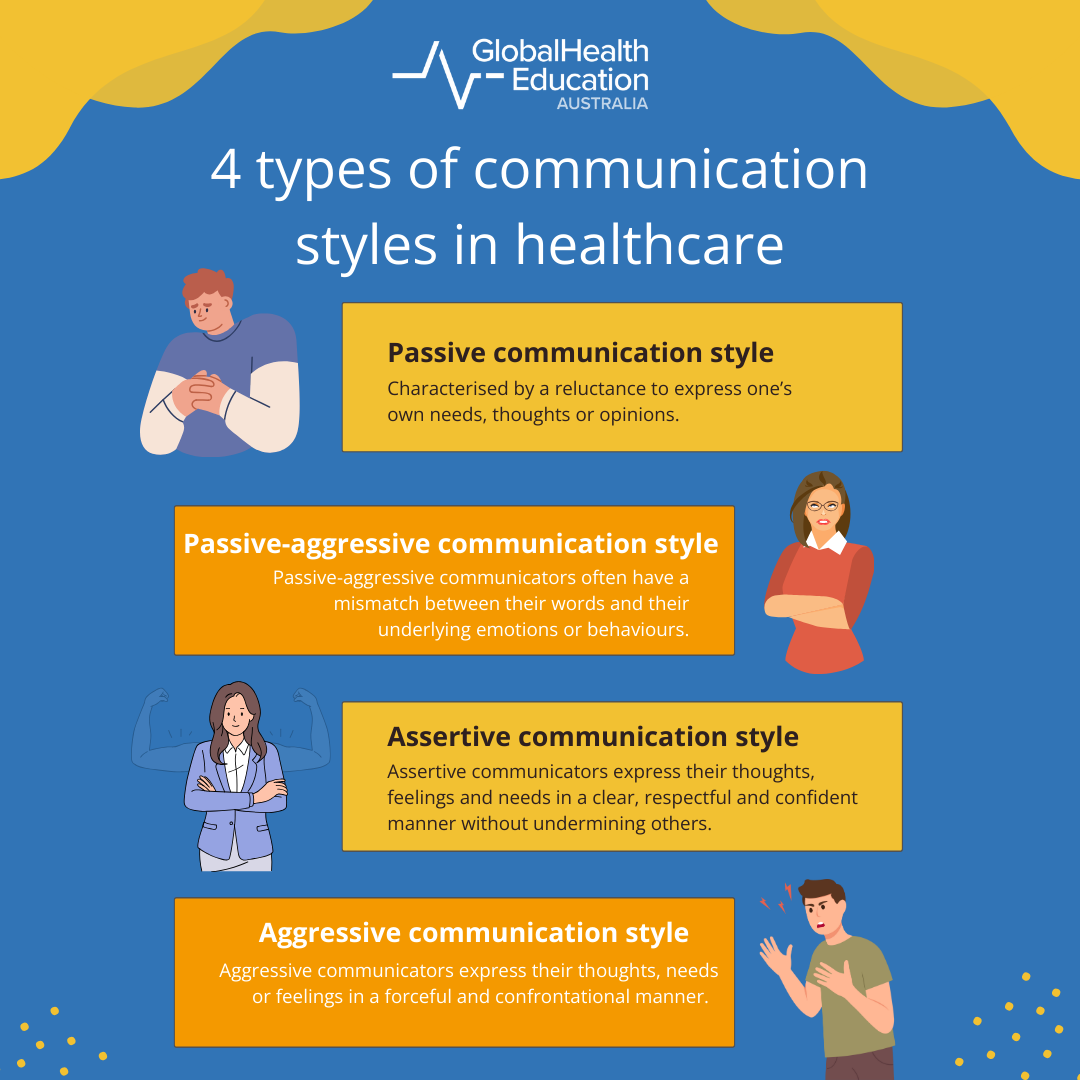
Recognising and adapting to different communication styles is important in healthcare as it helps minimise misunderstandings and cultivate stronger relationships, ultimately leading to improved results.
Psychologists and researchers commonly categorise communication styles into four types. Passive, passive-aggressive, assertive and aggressive.
Passive communication style
A passive communication style is characterised by a reluctance to express one’s own needs, thoughts or opinions. This can manifest as vague responses, excessive apologising or difficulty voicing concerns. Individuals who communicate passively often defer to others to avoid conflict, discomfort or feelings of guilt.
Here are some ways to identify a passive communicator:
Verbal indicators
These communication patterns can also manifest in written or electronic formats, such as overly apologetic emails or vague wording.
-
Excessive apologising
Passive communicators may apologise pre-emptively for expressing their opinions or asking questions.For example, a junior nurse might say, “Sorry to bother you. I wasn’t sure if I should change the dressing today. Sorry again,” to a senior nurse, even though it’s an entirely valid question. This behaviour can reflect a lack of confidence or anxiety about appearing demanding or assertive.
-
Vague responses
Passive communication often includes indirect or non-committal language to avoid conflict or fully expressing one’s needs. During a follow-up consultation, for instance, a post-surgery patient experiencing pain might respond with, “I think I’m okay” or “It’s probably nothing”, rather than articulating their discomfort. -
Soft or hesitant tone
Passive communication is also characterised by a reluctance to express oneself directly and assertively, which can translate into a soft or hesitant tone.For example, in a multidisciplinary team meeting, an allied health assistant might deliver a client update in a barely audible voice, using uncertain phrases like, “I’m not sure, but maybe…” or “I could be wrong, but…” which may reduce the impact of their input.
-
Reluctance to say no
Passive communicators often avoid saying no, even when overextended. For example, a nurse asked to cover a last minute shift might respond with, “I suppose I could cover the shift,” despite already working long hours.
💡 Individuals who have a passive communication style may have social anxiety, low self-esteem and poor confidence.
Non-verbal indicators
-
Avoidance of eye contact
Some passive communicators may find sustained eye contact uncomfortable due to low confidence or fear of judgement. For example, a client discussing their mental health during a counselling session might avoid eye contact throughout the conversation, looking down or away, even when gently prompted. -
Closed-off posture
A closed or defensive posture can signal discomfort or hesitation. For instance, during a routine physiotherapy session, a client may sit with their arms tightly crossed, shoulders hunched and gaze lowered. This closed-off posture suggests discomfort or hesitancy to speak openly. -
Fidgeting or physical signs of discomfort
In moments where they are required to speak up or share personal experiences, passive communicators may display physical signs of unease. A patient asked to describe their symptoms, for example, might avoid answering directly and instead shift in their seat, tap their foot or nervously wring their hands.
Passive-aggressive communication style
Passive-aggressive communicators often present a mismatch between their words and their underlying emotions or behaviours. On the surface, they may appear cooperative or agreeable, but their actions may subtly express resistance, resentment or disregard for other people’s needs and feelings. This communication style can be particularly confusing in healthcare settings where clear and direct communication is essential.
Here are some ways to identify a passive-aggressive communicator:
Verbal indicators
These behaviours can also appear in written or electronic communication.
-
Sarcasm
Passive-aggressive communicators often use sarcasm to express disagreement or frustration indirectly. For instance, a colleague might appear to agree with a new care protocol you’ve suggested, but then mutters, “Oh great, more work for us,” in a sarcastic tone. -
Backhanded compliments
These are comments that sound positive but carry an underlying insult or criticism. For example, a patient might say to a nurse, “You actually explained that well today for a change.” -
Playing the victim
Instead of owning their actions, passive-aggressive communicators may position themselves as unfairly treated. For example, after receiving feedback on how they’ve treated a client, a social worker might respond with, “No one ever listens to me anyway,” or “I guess it’s always my fault.” Deflecting the conversation and discouraging further dialogue. -
Intentional procrastination or forgetfulness
This could translate into a healthcare team member agreeing to complete a task but then verbally delaying it in subtle ways. For example, when asked about working on an urgent patient’s samples, a pathologist might respond with, “Oh, I was just about to do that. Been swamped with other things lately,” even if the task has been pending for days.
💡Passive-aggressive communication is often a learned coping strategy that develops when individuals grow up in environments where open emotional expression is discouraged or punished.
Non-verbal indicators
-
Tight or controlled facial expressions
While their words may suggest agreement, passive-aggressive communicators often display non-verbal cues that signal frustration or reluctance.For example, a health promotion coordinator might verbally agree to take on an additional project but simultaneously exhibit clenched jaw muscles, narrowed eyes or a tight-lipped smile. These non-verbal indicators may show that they feel overburdened or resentful, despite not voicing it directly.
-
Dismissive body language
Passive-aggressive communicators may use dismissive or resistant body language to indirectly express disagreement or annoyance. For instance, a clinician being asked to adopt a new digital documentation tool might sit back with their arms tightly crossed, roll their eyes during training or sigh audibly. -
Contradictory body language
A client may display passive-aggressive tendencies by using body language that contradicts their verbal agreement. For example, a patient might respond to new dietary restrictions by nodding but simultaneously they’re also tapping their fingers impatiently, yawning and pouting.
Assertive communication style
Assertive communication involves expressing one’s thoughts, feelings and needs in a clear, respectful and confident manner without undermining others. This communication style is widely considered the most effective and balanced communication approach in healthcare as it promotes mutual respect, reduces conflict and builds trust and rapport.
Verbal indicators
The indicators below can also manifest in written or electronic communication.
-
Clear and direct messages
Assertive communicators express themselves in ways that are easy to understand. For example, a client speaking with a counsellor might say, “I’ve been feeling overwhelmed lately and I’d like to talk through some coping strategies that might help.” -
Use of “I” statements
Rather than blaming others, assertive communicators tend to use “I” statements that focus on personal experiences or feelings. For example, a speech therapist feeling frustrated by frequent last-minute schedule changes might say, “I find it difficult to manage my caseload when changes aren’t communicated early. I’d appreciate more notice moving forward.” -
Expressing needs clearly
Assertive individuals typically avoid vague or overly passive language. So, instead of saying, “Maybe the care plan needs to be looked at again?”, a nurse might say, “I’d like to review the care plan together to make sure it aligns with the patient’s current needs.” -
Avoiding judgement or exaggeration
Assertive communicators stick to facts and express concerns calmly. For instance, instead of a patient saying, “Why are you not taking care of me properly?” they might say, “I’m still experiencing pain in my lower back, especially when I lie down. Could we look at adjusting my treatment plan?”
💡Assertive communicators also typically have good self-awareness and are able to regulate their emotions effectively while respecting the perspectives of others.
Non-verbal indicators
-
Good eye contact
Assertive communicators maintain steady, appropriate eye contact to convey confidence and show engagement. For example, a psychologist may maintain consistent eye contact while the client speaks, signalling attentiveness and genuine interest. -
Confident posture
Assertive communicators often sit or stand with a straight, yet relaxed posture without crossed arms or tense shoulders. For instance, during a multidisciplinary team meeting, an occupational therapist might sit upright and lean slightly forward when listening to colleagues, demonstrating engagement and confidence. -
Neutral and calm facial expression
An assertive communicator tends to have a facial expression that’s marked by a soft gaze, neutral brow and slight smile. For example, a general practitioner might maintain a gentle and reassuring expression when discussing sensitive health concerns with a patient or client.
Aggressive communication style
An aggressive communicator expresses their thoughts, needs or feelings in a forceful and confrontational manner, typically prioritising their own interests without regard for the perspectives or feelings or others. This style can be particularly disruptive in healthcare settings where collaboration and empathy are essential.
Here are some ways to identify an aggressive communicator:
Verbal indicators
Aggressive communication can also appear in written forms such as emails or messages. In such instances you might observe the behaviours below or other indicators such as all-caps text, blunt or curt responses.
-
Frequent interruptions
Aggressive communicators regularly interrupt others, preventing them from clearly expressing their thoughts or feelings. An example could be a nurse unit manager constantly interrupting team members, forcefully speaking over others and dominating the conversation. -
Dismissive language
Aggressive communicators often use dismissive or belittling language towards others, undermining or devaluing someone’s contribution. For example, a frustrated patient might have an angry outburst and verbally attack a nurse by saying, “You clearly don’t know what you’re doing.” -
Accusatory “you” statements
Aggressive communicators often use “you” statements as a tactic to blame or criticise the other person, rather than addressing the issue collaboratively. For example, a patient upset about a delayed test result might say, “You people never get anything right. How hard is it to follow up?” -
Emotionally charged and personal language
Rather than addressing issues calmly, aggressive communicators may use emotionally charged language or personal attacks to convey their frustration. For instance, a client in a counselling session may angrily respond to advice given by a counsellor by stating, “You’re clueless. You have no idea what I’m going through.”
💡While aggressive communicators may appear confident, this behaviour can stem from deep-seated insecurities, poor emotional regulation or a learned belief that aggression is necessary to be heard.
Non-verbal indicators
-
Dominating body language
Aggressive communicators often use posture to assert dominance or intimidate. For example, a client frustrated by their perceived lack of progress in their treatment might confront their physiotherapist in the gym area, standing with a tense, upright stance, shoulders squared and stepping forward into the physiotherapist’s space while speaking in a raised voice. -
Intense or piercing gaze
Eye contact in aggressive communication tends to be overly intense and unrelenting. A healthcare professional speaking to a colleague during a disagreement may lock eyes with a hard, narrowed stare accompanied by a furrowed brow, clenched jaw or even slightly bared teeth. -
Sharp or pointed gestures
Gestures are often fast, abrupt and accusatory. For example, a frustrated patient might point repeatedly at a nurse while speaking or make sharp hand motions to emphasise their dissatisfaction.
How to respond to each type of communication style
As a healthcare professional, you’re likely to encounter individuals who communicate in different styles. Understanding how to adapt to various communication styles is key to building trust and managing challenging interactions.
Luke Lawrence, director and principal psychologist at Explore Psychology, shares, “I’ll have clients who are 14 to 15 years old and my communication style with them is very different to a 60 to 65 year old [client] who’s had a lot more life experience and ways of understanding their own feelings.”
It’s also important to remember that communication styles are not fixed. For example, a person who typically communicates passively may communicate aggressively in high-pressure or emotionally charged situations. Recognising these shifts in behaviour and responding appropriately can help defuse the situation.
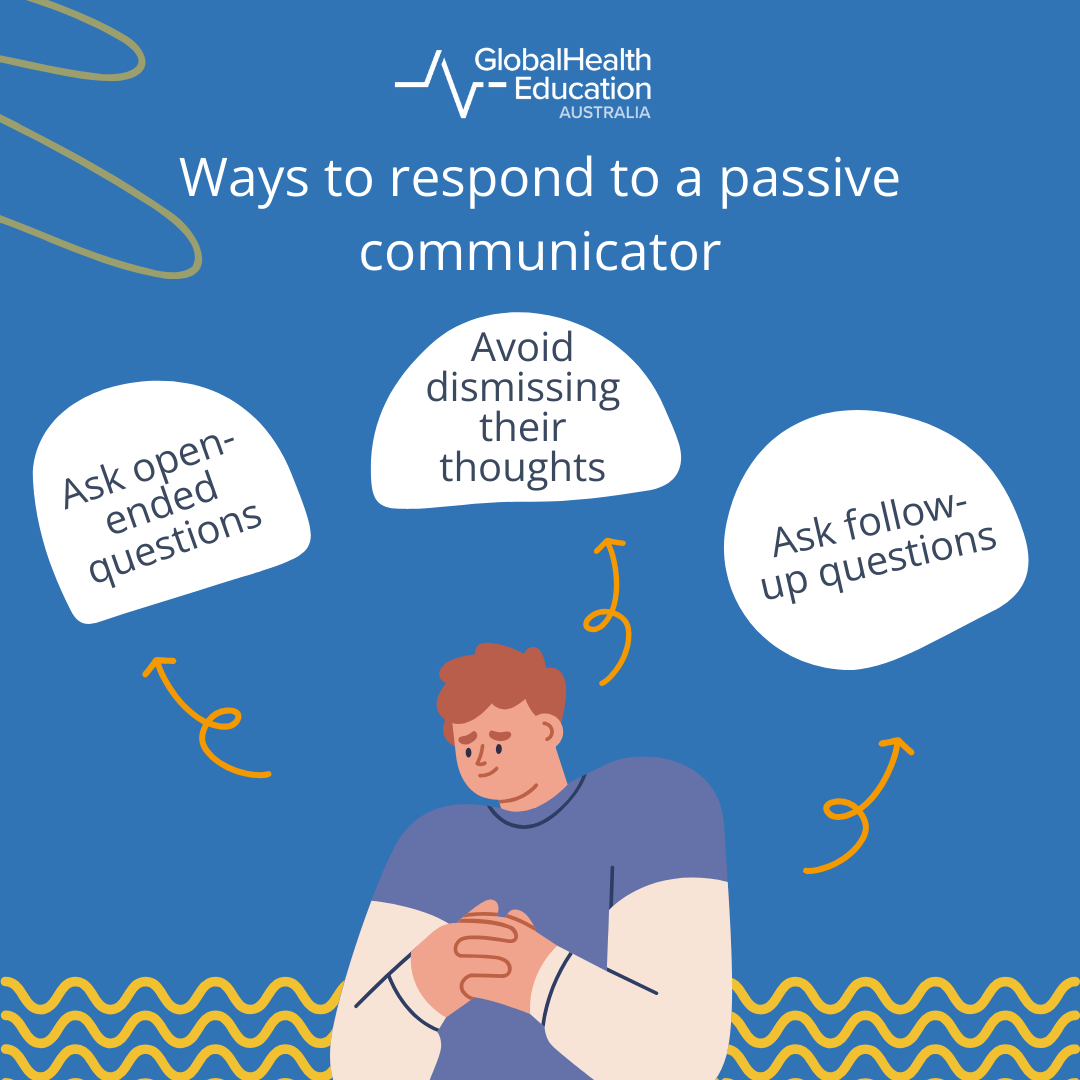
Responding to a passive communicator
When interacting with someone who uses a passive communication style, it’s important to create a safe, supportive environment where they feel heard and respected. In healthcare settings, this might mean being especially mindful with patients or clients who are hesitant to speak up or with colleagues who rarely share their opinions.
Here are some ways to respond to a passive communicator:
- Ask open-ended questions
Encourage elaboration by avoiding yes or no questions. For example, ask questions such as, “Can you tell me more about how you’ve been feeling since starting this medication?” and “What concerns do you have about your upcoming procedure?”
- Ask follow-up questions
If initial responses are vague or minimal, ask follow-up questions. An example could be, “When you say you’re not feeling great, what do you mean by that?”
- Give space for expression
Don’t rush to fill silences. Passive communicators may need more time to formulate their responses, so allow pauses in conversations and use affirming body language such as gentle nods to signal patience and interest.
Luke notes that in his field, working with clients who communicate passively may involve the need to “jump in and help the client to express themselves or allow them the time, space and safety to express themselves.”
- Avoid dismissing their thoughts
Acknowledge their thoughts or concerns by saying, “I appreciate you sharing that with me,” to help validate their perspective.
- Choose one-on-one conversations where possible
Passive communicators may feel overwhelmed in group settings, so having a one-on-one conversation may create a safer space for them to speak freely.
- Be approachable and non-judgemental
An open posture, soft eye contact and an inviting tone can help reassure them that they won’t be judged for what they share.
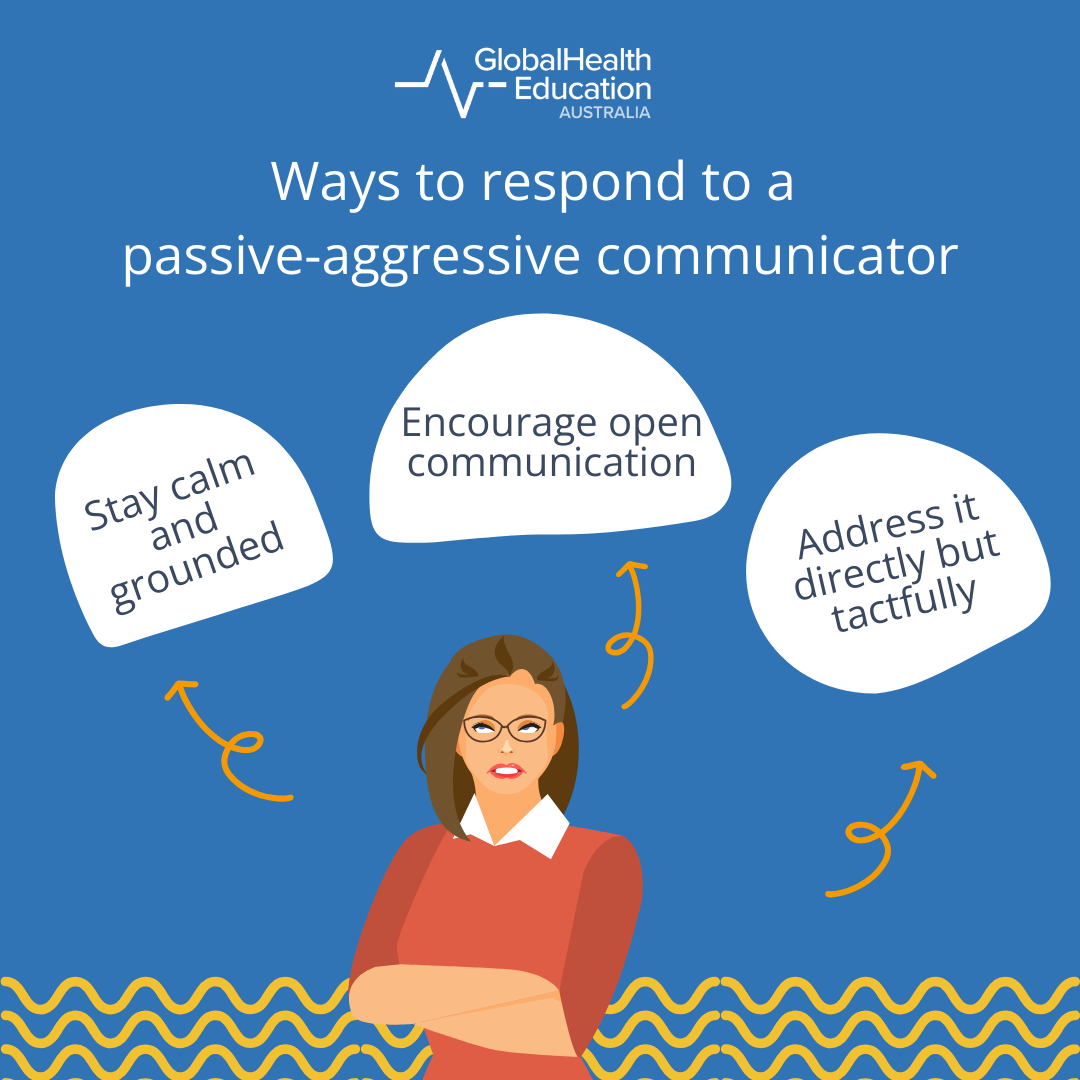
Responding to a passive-aggressive communicator
When speaking with someone who uses a passive-aggressive communication style, it’s important to remain calm, observant and open to discovering what’s being communicated beneath the surface. In healthcare, this may involve recognising when a patient or client’s sarcasm or indirect remarks signal unmet needs or when a colleague’s subtle resistance masks underlying frustration.
Here are some ways to respond to a passive-aggressive communicator:
- Stay calm and grounded
Avoid reacting defensively or matching their tone. Passive-aggressive behaviour often stems from unspoken frustration or discomfort so staying composed can help neutralise tension. For example, if a colleague responds to a last-minute shift swap with, “Sure, because I clearly have nothing else going on,” maintain eye contact and calmly respond, “Thanks, I understand it’s short notice and I appreciate your flexibility.”
- Address it directly but tactfully
Use non-confrontational “I” statements to surface the issue without placing blame. For instance, an occupational therapist responding to a passive-aggressive comment from a colleague might say, “I felt a bit confused by your comment earlier. Can we go over it together to make sure we’re on the same page?”
- Encourage open communication
Subtle remarks often signal a need that hasn’t been clearly expressed. You can gently invite honesty by prompting with curiosity. For instance, if a client says, “Well, at least someone got it right today,” you might respond with, “It sounds like something didn’t go as expected. Can we talk about it so we’re aligned moving forward?”
- Set clear expectations
Passive-aggressive communicators can thrive in ambiguity. Setting boundaries and expectations respectfully can re-establish clarity. For example, a case manager might respond to a sarcastic comment about caseloads by saying, “If there are any concerns about caseload distribution, please bring them up in our weekly check-in so we can address them together.”
- Don’t mirror the behaviour
As tempting as it might be, resist the urge to respond with sarcasm or avoidance. For example, if a patient makes a snide remark about your care, continue with neutral, empathetic language such as, “I want to make sure we're addressing your concerns. Can you help me understand what’s not working for you?”

Responding to an assertive communicator
When working with or speaking to someone who communicates assertively, it’s important to recognise and value this communication style. Assertive communicators tend to express their thoughts confidently while respecting the needs of others and mirroring this approach can help with building trust and establishing open and respectful communication.
Here are some ways to respond to an assertive communicator:
- Acknowledge and show appreciation for their communication style
Recognising assertive communication styles helps build rapport and reinforce positive communication behaviours.
For example, if a health promotion officer raises concerns during a team meeting and says, “I believe our messaging could be more inclusive, especially for culturally diverse groups,” you might say, “Thanks for raising that. I appreciate how clearly you’ve framed the issue. Let’s explore how we can improve it.”
- Mirror their communication style
When engaging with an assertive communicator, it’s helpful to reflect a similar level of directness, clarity and respect. This doesn’t mean mimicking their words but adopting a tone that’s open, constructive and confident.
- Remain open
Assertive communicators often provide honest, constructive feedback that can be easy to misinterpret if you’re feeling tired or under pressure. In this instance, it’s important to remain open and grounded.
For example, a public health manager might say, “The documentation yesterday was a bit unclear, just flagging it so we can make changes and ensure we’re on the same page.” Rather than reacting defensively, an open response might be, “Thanks for letting me know, Iet’s set up a meeting to discuss.”
- Clarify if you’re unsure
Assertive communicators value clear, two-way communication. If something isn’t clear, asking for clarification shows engagement and prevents errors.
For example, if a patient says, “I’d like to explore alternatives to this medication. I’ve been feeling off since I started it,” a nurse might respond, “Thanks for raising that. Can you tell me more about the symptoms you’ve noticed so we can figure out the next steps?”
Luke notes that in his field, working with clients who communicate passively may involve the need to “jump in and help the client to express themselves or allow them the time, space and safety to express themselves.”

Responding to an aggressive communicator
In healthcare, you may occasionally encounter clients, patients, colleagues or stakeholders whose communication style is forceful, hostile or confrontational. This behaviour can stem from fear, pain, frustration or a perceived lack of control, especially in high-stress environments. While it’s important to remain empathetic, it’s equally essential to maintain professionalism, ensure safety and de-escalate the situation without mirroring aggression.
Here are some ways to respond to an aggressive communicator:
- Remain calm and be assertive
When dealing with an aggressive communicator, Madeline Kessler, a nurse coach and emotional health educator, shares that it’s important to stay calm while also maintaining an assertive communication style. An aggressive tone or confrontational words can trigger defensiveness, but remaining grounded allows you to maintain control of the interaction.
For instance, if a patient begins shouting, “This is useless, no one here listens to me!”, you might calmly respond with, “I hear how frustrated you are. Let’s take a moment so I can understand what’s going on and how I can help.”
- Set firm but respectful boundaries
Boundaries are essential when aggressive behaviour threatens the wellbeing of staff or others. For instance, if a client is swearing or raising their voice during an appointment with a social worker, they might respond with, “I want to support you but I need us to speak respectfully so we can work through this together. If that’s not possible right now, we can take a moment and try again in a few minutes.”
- Focus on the underlying issue
When faced with aggression, it’s easy to get caught up in the emotional tone of the interaction. Instead, try to steer the conversation towards the actual concern or problem at hand, this helps keep the discussion productive without escalating tensions.
For example, if a client snaps and says, “What’s going on? How is it that I’ve seen no improvement after all of these sessions?” The physiotherapist might say, “It sounds like you’re feeling frustrated with how your recovery is going. Let’s take a look at your current plan and see what adjustments we can make.”
- Seek support or step away when needed
When a situation feels unsafe or continues to escalate, involving another team member or stepping away could help prevent the situation from spiralling into further conflict.
Understanding the modes of communication in healthcare
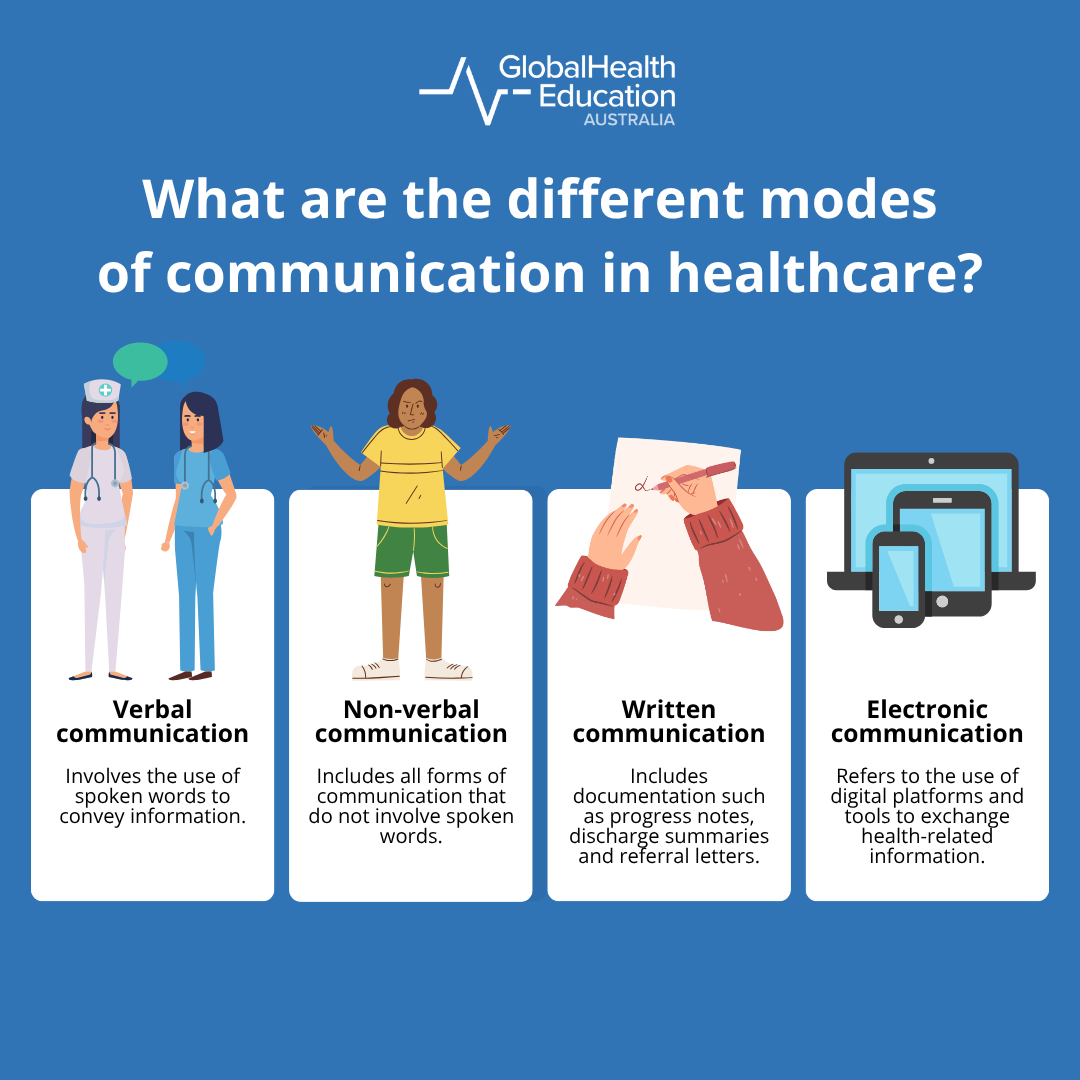
Communication modes refer to the methods or formats through which information is delivered. This differs from communication styles, which are about a person’s approach or manner when communicating.
In healthcare, the four main modes of communication are verbal, non-verbal, written and electronic. Mastering each mode is vital as they all play a critical role in ensuring that information is conveyed clearly and accurately.
Verbal communication
Verbal communication involves the use of spoken words to convey information. In healthcare, verbal communication is essential for sharing critical updates, discussing treatment options, building rapport and coordinating care.
Examples of verbal communication in healthcare
- A nurse conducting a bedside handover during a shift change, clearly summarising the patient’s progress and medication schedule
- A doctor explaining test results and treatment options to a patient and their family using simple and non-technical language
- An occupational therapist calling a patient post-discharge, speaking in a clear and concise manner to discuss home safety adjustments
Tips for effective verbal communication
-
Be clear and concise
Use straightforward language and focus on key points. Avoid rambling or overloading the listener with too much information at once. -
Adapt your language
Tailor your communication to suit the person’s age, cultural background and level of health literacy. -
Avoid jargon
Replace medical acronyms and complex terminology with plain English. -
Ask open-ended questions
Encourage dialogue by posing questions that require more than yes or no answers. -
Confirm understanding
Utilise techniques like the teach-back method, which involves asking patients or clients to repeat information in their own words to ensure comprehension.
Non-verbal communication
Non-verbal communication includes all forms of communication without spoken words. This includes body language, facial expressions, gestures, posture, eye contact and even physical proximity. These subtle yet powerful signals play a crucial role in conveying empathy, reassurance and understanding.
In many healthcare situations, non-verbal cues can reveal more about how someone is feeling than their words. As Madeline states, “If someone doesn’t tell you verbally, they’ll tell you through their body language.”
Examples of non-verbal communication in healthcare
- A clinician maintaining steady, comforting eye contact and an open posture while delivering sensitive or difficult news to a patient
- A client showing signs of distress or anxiety by avoiding eye contact and having tense body language
- A nurse gently placing a reassuring hand on a patient’s shoulder to provide emotional support
💡 According to research conducted by behavioural psychologist Dr. Albert Mehrabian, body language makes up 55 per cent of our communication.
Tips for effective non-verbal communication
-
Use open body language
Maintain an approachable stance by keeping your arms uncrossed and your posture neutral. -
Maintain appropriate eye contact
Sustained, respectful eye contact demonstrates attentiveness and empathy. While it’s important to avoid staring, you should also avoid completely diverting your gaze as this may be perceived as disinterest. -
Be mindful of your posture
Leaning forward slightly can indicate active listening and engagement. Conversely, behaviours such as slouching, checking your watch or looking around the room may signal impatience or disconnection. -
Use affirming gestures
Simple non-verbal signs like nodding while a person is speaking can communicate that you’re listening and understanding what they’re saying. -
Maintain a calm and reassuring facial expression
Aim for a soft and relaxed face where your brows are unfurrowed, your jaw unclenched and your mouth is neutral or in a slight smile.
Written communication
Written communication in healthcare includes documentation such as progress notes, discharge summaries, referral letters, health promotion resources and prescriptions. Accuracy, clarity and completeness are essential as these documents may guide patient and client care, inform community health actions or affect clinical decisions across various healthcare settings.
Examples of written communication in healthcare
- A clearly structured referral letter from a GP to a specialist outlining patient history, symptoms and management requests
- Detailed discharge summaries that include clear instructions on medications, follow-up care and signs to watch for after leaving the hospital
- A public health officer developing a health promotion resource that’s written in plain language for easy understanding
💡 In Australia, about 44 per cent of adults read at literacy level one to two (a low level), 38 per cent read at level three and about 15 per cent read at level four to five (the highest level), so it’s essential to keep your written documentation simple and concise.
Tips for effective written communication
-
Use plain language
Avoid jargon where possible, define any technical terms and break complex concepts into smaller, more digestible parts. -
Incorporate adequate white space
Apply clean, consistent formatting to enhance readability. Use sufficient line spacing and headings to prevent visual clutter. -
Structure information logically
Present the most important points first and organise content in a logical sequence. Use headings, bullet points and concise paragraphs to guide the reader through the material. -
Tailor content to the audience
Adapt the tone, complexity and vocabulary of your writing based on who will be reading it. For example, healthcare professionals may require precise technical details whereas patients and clients may benefit from easy to understand language. -
Enhance visual accessibility
Support written content with visual aids such as diagrams, charts or icons, particularly when communicating with audiences who may have low health literacy.
Electronic communication
Electronic communication refers to the use of digital platforms and tools to exchange health-related information. This includes secure messaging systems, emails, electronic health records, telehealth platforms and electronic prescriptions.
As healthcare becomes increasingly digitised, electronic communication plays a central role in streamlining workflows, enhancing care coordination and improving accessibility.
Examples of electronic communication in healthcare
- Clinicians securely messaging colleagues to quickly clarify medication dosages or patient or client details
- Patients or clients accessing their test results or medical histories via secure online portals
- Electronic prescriptions transmitted directly to pharmacies, enhancing convenience and reducing errors
💡 The Australian Digital Health Agency reports that approximately 23.8 million Australians have a My Health Record as of March 2024. A My Health Record is a secure, online summary of an individual’s health information in Australia.
Tips for effective electronic communication
-
Prioritise clarity and brevity
Keep messages concise and well-structured. Where possible, use bullet points or short paragraphs to enhance readability, especially when conveying critical updates or instructions. -
Use secure platforms
Always use encrypted, healthcare-approved systems for transmitting data to protect privacy and comply with legal and ethical obligations. -
Proofread before sending
Typos or unclear language can lead to serious misunderstandings. Take a moment to review your message for accuracy, tone and clarity before sending it. -
Be mindful of tone
Without verbal or visual cues, tone can be easily misinterpreted. Use respectful, neutral language and avoid using all caps, slang or ambiguous statements. -
Confirm receipt when necessary
For time-sensitive messages, request a read receipt or follow-up to ensure the message has been received and understood, particularly if action is required.
Tips on improving your communication skills in a healthcare setting
Effective communication doesn’t always come naturally. However, with intention and practice, healthcare professionals can strengthen their communication skills and build more meaningful and constructive interactions.
Here are some ways to strengthen your communication skills:
-
Practise in low-pressure environments
Like any skill, communication improves with repetition. Practising in low-pressure environments can help build confidence and prepare you for more difficult interactions. In Madeline’s case, she suggests “having difficult conversations with trusted people in your life and practising being vulnerable.” -
Seek feedback and support
If you’re looking to improve your communication skills, Luke mentions speaking with your supervisor or manager and letting them know what challenges you’ve been facing. They might be able to offer some helpful tips or strategies based on their own experience. -
Focus on active listening
Often, communication breakdowns stem from people feeling misunderstood rather than unheard. That’s why it’s important to practise active listening by giving full attention to the speaker, using open body language and paraphrasing or summarising to confirm understanding. -
Learn to use the assertive communication style
Assertive communication is often described as the “gold standard” in healthcare. Unlike aggressive communication, it doesn’t dominate or intimidate, and unlike passive communication, it doesn’t retreat or avoid conflict.The best way to develop an assertive communication style is to practise expressing your opinions and needs clearly, using “I” statements, maintaining appropriate eye contact and body posture and being mindful of your emotions.
-
Boost your communication skills with further study
According to a report by The Royal Australian College of General Practitioners (RACGP), a study found that primary care physicians who did an intensive education program in mindful communication saw an improvement in both patient outcomes and personal wellbeing.Some ways that you can improve your communication skills include pursuing simulation or experiential training, short courses or a postgraduate course.
Some examples of postgraduate courses to consider include:
Master of Nursing Majoring in Leadership and Management at James Cook University
As part of this course, you’ll complete a unit titled Professional Communication in Healthcare where you’ll develop advanced communication strategies for navigating complex conversations and interpersonal dynamics.
You’ll also explore persuasive communication techniques relevant to the healthcare workplace and critically analyse key communication theories to inform your professional practice.
Master of Mental Health at Southern Cross University
In this two-year, part-time program, you’ll have the option to undertake an elective called Management Communication. This unit introduces essential theories and practices in leadership communication, covering topics such as writing styles and interpersonal, collaborative and corporate communication.
Master of Nursing (Chronic Disease and Ageing) at Victoria University
As part of your studies, you’ll undertake a specialisation unit titled Ageing and Chronic Disease. This subject focuses on supporting older individuals living with chronic conditions as well as their families and carers. In addition to clinical knowledge, you’ll also learn communication techniques and explore the interpersonal skills required to build and sustain effective therapeutic and professional relationships.
Master of Healthcare Leadership at Southern Cross University
While this course focuses on building skills in evidence-based care and leading teams of healthcare professionals, it also equips you with practical communication skills for engaging effectively with a wide range of stakeholders.
The courses below are listed by qualification level, from lowest to highest.








Strengthen your communication skills to become a better healthcare professional
Understanding how to identify and appropriately respond to different communication styles isn’t just a useful skill, it’s essential in healthcare. After all, communication is a fundamental pillar of healthcare and improving it can significantly improve health outcomes.
At GlobalHealth Education, we help individuals find the right health course in Australia. Choose from a wide range of courses in psychology, counselling, nursing, mental health, healthcare leadership and management, public health and social work that can assist with developing your communication skills. To apply, simply select a course and enquire to speak with a Student Enrolment Advisor.
Book a free professional development strategy call and connect with our Education Consultant, Catriona.













